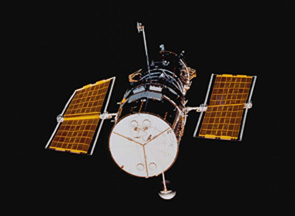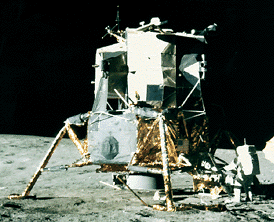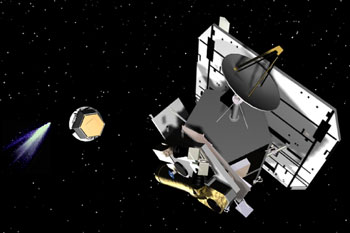View of Apollo 11 spacecraft on launch pad
Click on image for full size
NASA
Apollo 11
Driven by a recent surge in space research, the Apollo program hoped to add to the accomplishments
of the Lunar Orbiter and Surveyor missions of the late 1960's. Apollo
11 was the first mission to succeed in landing a person on the
surface of the moon. On July 16, 1969, the U. S. rocket Saturn 5 was
launched and three days later successfully deployed the lunar landing
module Eagle which landed in the Moon's Sea of Tranquility. On July
20, millions of people back on Earth watched and listened as ast
ronaut Neil Armstrong prepared to walk on the lunar surface.
"One small step for man, one giant leap for mankind". With these historic words, Armstrong became the first human to set foot on the Moon, at 10:56 pm, leaving his footprint etched in the lunar soil. Over the next 2 1/2 hours, he and astronaut Edwin Aldrin took color photographs, collected soil and rock samples, and raised the American flag, while walking around on the Moon. They also set up several experiments including a seismometer, a laser
reflector and a sheet of aluminum to collect particles from the solar wind.
Apollo 11 returned to Earth on July 24, 1969, safely splashing down in the Pacific ocean. By sending a human to the Moon and returning him safely to the Earth, the Apollo 11 mission met President Kennedy's challenge made earlier that decade, and it wi
ll remain one of the greatest technological achievements of all time.
You might also be interested in:

During 1966 through 1967, five identical Lunar Orbiter spacecrafts were launched, with the purpose of mapping the Moon's surface and finding smooth, level terrain, in preparation for the Apollo and Surveyor
...more
The Surveyor missions of 1966 through 1968 were the next step in space travel to the Moon, following the Ranger missions. Their goal was to perform "soft" landings on the lunar surface, meaning that the
...more
The Hubble Space Telescope (HST) was one of the most important exploration tools of the past two decades, and will continue to serve as a great resource well into the new millennium. The HST is credited
...more
Driven by a recent surge in space research, the Apollo program hoped to add to the accomplishments of the Lunar Orbiter and Surveyor missions of the late 1960's. Apollo 11 was the first mission to succeed
...more
Apollo 12 survived a lightning strike during its launch on Nov. 14, 1969, and arrived at the Moon three days later. Astronauts Charles Conrad and Alan Bean descended to the surface, while Richard Gordon
...more
Apollo 15 marked the start of a new series of missions from the Apollo space program, each capable of exploring more lunar terrain than ever before. Launched on July 26, 1971, Apollo 15 reached the Moon
...more
NASA chose Deep Impact to be part of a special series called the Discovery Program on July 7, 1999. In May 2001, Deep Impact was given the "go" from NASA to start with mission development. Deep Impact
...more














